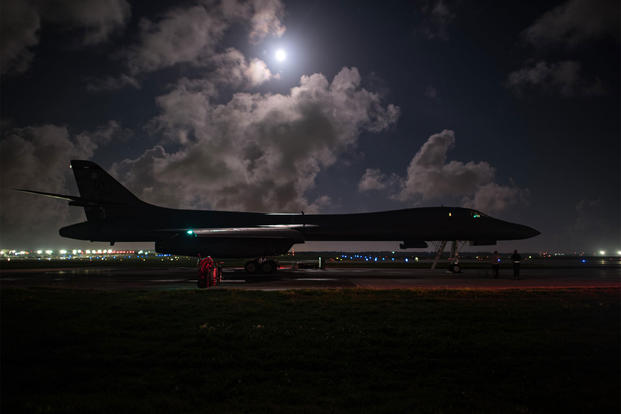Every year, 10 Russian officials travel to either the Ellsworth or Dyess global strike air bases in the United States to review the fastest bomber in the Air Force's arsenal: the B-1B Lancer.
It's no surprise, since the routine visit marks whether the Lancer -- capable of carrying the largest bomb-load of all the bombers -- complies with the Strategic Arms Reduction Treaty negotiations, which specifies the once-nuclear bomber remains disarmed of nukes.
It's why the "nuclear capable" description often given to the Lancer is erroneous -- it will never be a nuclear-capable bomber again, officials recently told Military.com.
"The exterior attachment points, or the hard points, on the aircraft, were modified to prevent nuclear pylons from ever being attached to the jet," said Master Sgt. Brian Hudson, a B-1 avionics manager at Air Force Global Strike Command.
Related content:
- Air Force: We Want 165 Bombers, Not Just B-21s
- Air Force 'Flexible' on B-1's Return to Fight Against ISIS
- Military.com Equipment Guide: B-1
"Within the weapons bays themselves, there were wire bundles that were cut and removed to prevent arming of the nuclear weapons. Finally, the last step was to destroy the pylons themselves," Hudson said of the external equipment mounted to aircraft.
The conversion process was initiated under the START Treaty, and the final conversion took place in 2011, he said.
Since that final bomber-jet conversion, "as part of the treaty now, [the Russians] are allowed to look at each base once a year, Ellsworth [in South Dakota] and Dyess [in Texas], they go every other year to each of those locations ... and confirm that we haven't unconverted them," added Kenneth Vantiger, senior arms control analyst at the command.
"It's a moot point," Vantiger said of what it would cost, or what it would take to make the B-1 nuclear capable again.
But is it impossible?
"Anything is possible with money and time," Vantiger said. "But it's nothing the U.S. government is looking to do."
"It isn't so much the cost of converting the plane to carry nukes; that would be relatively minimal," added Richard Aboulafia, vice president and analyst at the Teal Group, a defense consultancy in Virginia.
The bigger issue is "the costs associated with giving the plane the ability to penetrate defended airspace, which would be $2-3 billion dollars, at least," Aboulafia said in an email.
So far, there have been no plans to do defensive upgrades other than ongoing modifications to the aircraft.
The Air Force in late 2002 canceled the B-1B's intended Defensive System Upgrade Program, known as DSUP, because of cost overruns and schedule slips.
DSUP, which would have enhanced the aircraft to better survive in a hostile environment, fell under the bomber's switch to become a conventional-only platform. But the program was already roughly $1 billion, with the likelihood of being 17 months delayed and $175 million more over budget, the Air Force said at the time.
So the conversation once again turns to keeping the B-1B around longer -- at least until 2040, officials have said. And keeping planes flying still comes at a price.
Stayin' Alive
Lately, the B-1B, which made its first flight in 1984, has been the face of deterrence in the Pacific Command's area of responsibility. Since the aircraft replaced the B-52 Stratofortress in the theater for the U.S.' continuous bomber presence mission last August, it has had a few runs near the Korean Peninsula, as well as the South China Sea.
The shift marks the first time the B-1B has been housed at Andersen Air Force Base, Guam, since 2006.
Just one month into its PACOM deployment, for example, the bomber, nicknamed the Bone, performed a low-level flight near the Demilitarized Zone, the closest a Lancer has ever flown to the border of the Republic of Korea and North Korea since 1996, the Air Force said at the time.
More recently, Japanese and South Korean fighter jets escorted two B-1 bombers during a show of force after North Korea fired its first intercontinental ballistic missile test, this time dropping dummy bombs in South Korea's Pilsung Range.
To keep it viable in such situations, the Air Force in 2012 initiated the largest-ever modification the bomber will see -- at least, in the near term.
The modifications, part of upgrades known as the Integrated Battle Station, or IBS, "integrates three developmental programs already in the works: the central integrated test system, a fully integrated data link, and the vertical situation display upgrade," Hudson said.
"The IBS program is focused on sustainment, but it significantly enhances the operator's situation awareness," he said.
The central integrated test system, or CITS, works as a diagnostic and recording system to give crew more information while in flight, as well as diagnostic information for maintainers on the ground, Hudson explained.
The plane is already outfitted with the Joint Range Extension Applications Protocol, known as JREAP, which extends tactical data link communications over long-distance networks.
But the Fully Integrated Data Link, or FIDL, gives "the addition of Link 16, so really what FIDL [does] is to add Link 16 and integrate with beyond-line-of-site JREAP, and merge those two together and push that information onto the displays inside a cockpit," said Maj. Jeremy Stover, the B-1 program element monitor and instructor weapons systems officer.
Link 16 supports digital exchange of imagery and data in near-real time with aircraft, ships and some ground vehicles.
The total program cost for IBS is estimated at $1.1 billion, officials said.
Col. Robert Lepper, chief of the combat aircraft division at AFGSC, said there are 33 aircraft slated for IBS conversion by 2020; the Air Force currently has 62 B-1B Lancers.
"This brings us into the 21st century with digital information out there in the cockpit -- it reduces our need for both old, unobtainable and unsupportable parts," he added.
Lepper said this streamlines how the B-1B -- now a Boeing craft, previously Rockwell -- receives upgraded systems and parts should they too deteriorate over time.
The bombers are also undergoing a service life extension of their engines, Stover said. "It's mostly internal parts, and the kit includes ... commonality with the F101 engines," he said.
The Air Force has completed work on 14 engines, with the rest slated to be done by December 2019.
New Bombs
Stover said crews are getting ready to test-fire the air-launched Long Range Anti-Ship Missile, or GM-158C LRASM.
"We should field that by October 2018," he said of the estimated $1.5 billion Navy program, also being tested on the F/A-18 Super Hornet.
Once launched from the aircraft, the cruise missile will be able to autonomously sensor-locate and track targets while avoiding friendly forces.
The weapon will enhance not just the B-1, but the U.S. military's targeting capabilities while protecting at-risk assets in a high-threat environment, Stover said.
He noted, "No jet has been modified" physically to carry LRASM, because "it's part of a software update."
"This is just the next weapon we're looking to integrate, and we're going to continue to look at integrating future weapons as they get developed," Stover said.
Currently, the B-1 can carry 75,000 pounds -- 5,000 pounds more than the B-52 -- of both precision-guided and conventional bombs, to include: the Mk-82 or Mk-84 general purpose bombs; the Mk-62 or Mk-65 Quick Strike naval mines bombs; cluster munitions such as the CBU-87, -89, -97 or Wind-Corrected Munitions Dispensers like the CBU-103, -104, -105; the GBU-31 or GBU-38 Joint Direct Attack Munitions; the AGM-158A Joint Air-to-Surface Standoff Missiles; and the GBU-54 Laser Joint Direct Attack Munitions.
For LRASM, "The B-1 is the only Air Force platform scheduled to receive this, and we are the threshold platform for [it]," Stover said.
The B-1 may be capable of carrying more than 20 LRASMs at a given time.
Where It's Needed
The B-1s returned from Operation Inherent Resolve, the Pentagon's name for the air operation against the Islamic State in Iraq and Syria, in early 2016. Months later, the B-52s arrived to take over in the bomber role, and have been taking the lead on "attacking everything from vehicles to large-site targets," officials told Military.com in October.
But the Lancer's departure has been noted by a few who say its long-range, large payload is needed to aggressively strike deliberate or dynamic targets in an ever-increasing and changing environment.
For one, it had deployed the most weapons of any aircraft involved in the campaign before its departure, according to statistics provided to Air Force Times last March. Recent statistics provided to Military.com show the F-15E Strike Eagle has usurped that title.
Air Force Chief of Staff Gen. David Goldfein addressed the B-1's return to the ISIS fight in February, saying the aircraft "will go back in, but we're remaining pretty flexible on the timeline on that."
"You're just going to see a continual rotation of both of those weapons systems," Goldfein said at the time.
Lepper said that a handful of B-1s are often out of rotation for the IBS modification, making its aircraft availability rate lower than its bomber counterparts. The aircraft availability rate "right now is just over 40 percent," he said, "but like I said, we're taking a 10 percent hit -- six out of 62 airplanes -- to do this modification."
"We use [all the bombers] where they make the most sense," Lepper said. "The B-2 [Spirit] has stealth, B-1 has speed, B-52 has capabilities to include the highest mission capable rates, so it's availability," he said.
He added, "For us, the B-1's specific advantages [often] make it the [aircraft] of choice: speed, its ability to stay overhead for long periods of time -- it is the largest payload-carrying bomber in the fleet."
Where or how it is used tactically in future missions doesn't concern officials readying the fleet, but rather how it stays relevant.
It's about "getting a fully functioning fleet of entire B-1s IBS-modified … that is where our focus is at right now," Lepper said.
"That is significant in the logistic arena to make sure the airplane is sustainable but, as a weapons system, it remains a significant deterrent for our adversaries all across the globe," he said.
-- Oriana Pawlyk can be reached at oriana.pawlyk@military.com. Follow her on Twitter at @Oriana0214.






























